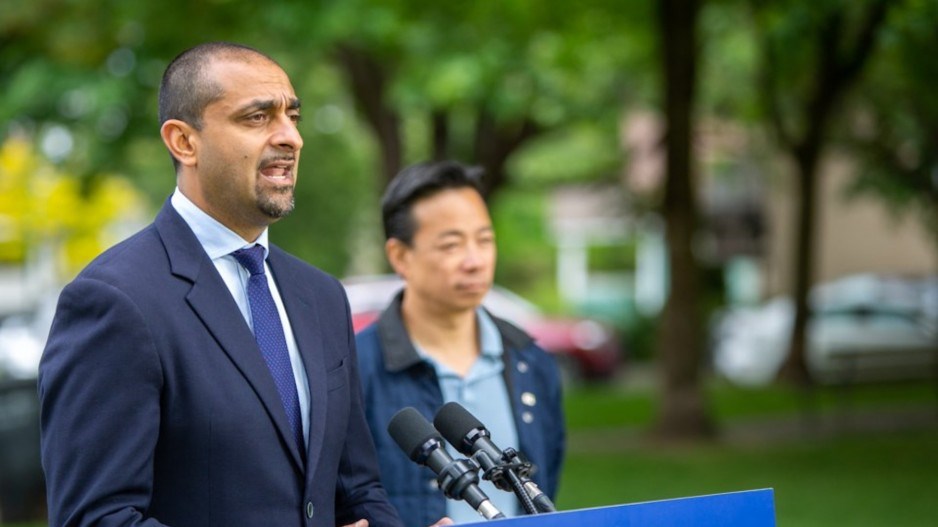The B.C. government has placed Vancouver and nine other municipalities in the province on a “housing target” list in what is a legislative-driven push to get cities to build more homes — and build them faster.
But while Housing Minister Ravi Khalon said he expected most of the communities “will be cooperating fully with this” a cursory examination shows that all have recently increased development cost charges (DCCs) and other fees that will make all new homes more expensive.
Kahlon released the list – quickly deemed the ‘naughty list’ by media – at a May 31 news conference in a Vancouver park, where he was joined by Vancouver Mayor Ken Sim and representatives of the non-profit housing sector.
“While housing affordability is a challenge in communities across British Columbia, we selected these municipalities on an objective, thorough and measured process that factored in housing availability, affordability and unrealized potential in delivering more homes for people,” said Kahlon.
The nine other municipalities are: City of Abbotsford, City of Delta, City of Kamloops. District of North Vancouver, District of Oak Bay, City of Port Moody, District of Saanich, City of Victoria and District of West Vancouver.
For example, Vancouver’s development fees for a new 2,000-square-foot detached house will increase this September from $14,800 to $16,500 as the rate moves to $8.40 per square foot, including laneway houses. A new ‘medium-density’ housing unit will have a development fee of $17.72 per square foot, or more than $21,000 for a new 1,200-square-foot townhouse.
Vancouver also charges community amenity contributions, which developer’s pay to cover the cost of such things as parks, playgrounds or day-care space. These rates will increase sharply this September.
The increases for multi-family buildings in the Grandview-Woodlands area will rise 56 per cent to $40 per square foot and increase 111 per cent in the Norquay-Kingsway area of East Vancouver. The Cambie Corridor would see CACs for new six-storey multi-family units increase 56 per cent to $185 per square foot. Combined with DCCs, the total per-unit fees for a new 1,000 square-foot Cambie apartment could total nearly $200,000.
After a recent hike, District of North Vancouver DCCs are now $32,269 per each detached house. Based on the charge per square foot, a 1,000 square-foot townhouse requires $17,500 in fees and a similar sized new apartment is nailed with $18,350 in DCCs.
Similar increases are seen in other Metro and Island cities and districts on the naughty list.
Kamloops has also seen an increase, bringing the DCCs for a detached house to $16,400, up from $11,673, and raising the flat fee for multi-family units about 50 per cent to $12,661 in 2023.
Housing Supply Act
In November 2022, the B.C. government introduced the Housing Supply Act to give it the authority to set housing targets in municipalities, starting with those with the greatest need and highest projected growth.
The targets are supposed to encourage municipalities to address local barriers to construction so that housing can get built faster, including updating zoning bylaws and streamlining local development approval processes.
Final targets for each of the 10 municipalities will be released this summer, said Kahlon, who took reporters’ questions on what happens if a municipality doesn’t abide or meet the targets set by government.
“We need all communities to be participating in that work, and I expect most communities will be cooperating fully with this,” said the minister, noting the government can bring in an independent advisor after six months to determine where barriers exist for a municipality to reach a target.
“And if we find that progress isn't being made, then we have the ability as a province to step in and make the decisions we believe are necessary to ensure affordable housing in communities.”
A second group of 27 municipalities was added to the list in June.
Sim welcomed Vancouver’s addition to the housing target list, saying that as the biggest municipality in the province, it has a responsibility to lead by example. The mayor added that Vancouver can’t do it alone when it comes to providing more housing for people.
“These challenges impact our region and province as a whole,” Sim said. “And the reality is we need to build more housing faster. We need more social housing, more supportive housing, more rental housing, more affordable home ownership — basically, we need more of everything.”
A housing strategy update in April showed more than 11,000 homes were under construction in Vancouver, with 47 per cent of them rental.
Sim noted that in the past six months, the city fully digitized the city’s permitting process, streamlined application and review streams, is piloting “an innovative program on the missing middle”.
The mayor failed to mention Vancouver’s increase in DCCs or CACs during the press conference.




